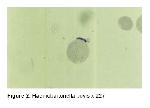A three year old unhealthy Brown Swiss cattle showing the signs of fever (41,0 °C), loss of appetite and exhaustion was submitted from Bulanık/Muş in December 2002. These signs were observed nearly one month ago, and anemia was determined in the clinical inspection. In the microscopic examinations of blood smears stained with Giemsa; round-shaped Eperythrozoon wenyoni, in the numbers ranging from one to 50, was observed only on the surface of erythrocytes in highly-dense parasitemia, while chain-shaped Haemobartonella bovis was seen on the peripher of erythrocytes in less-dense parasitemia. In addition, a few Theileria sp. were detected in the microscopic examination.
In clinical examination, tick was not found on the animal and swelling was not present in lymph glands. Body temperature, heart frequency and respiration number were found 41.0 °C, 92 and 36 respectively. Ruminal movement was observed 5/5min. In examination of ruminal content, PH was 7.0, infuzoria amount was ++-, in blood examination; RBC was found to be 2.0x10 6/cu mm, MCV 76/cu μ and PCV 20%. Presence of anemia was revealed with these results. The microscopic examinations of blood smears dyed with Giemsa showed 1-50 items of round and roundish shaped E. wenyoni (Figure 1) in dense parasitemia only on the surface of erythrocytes, chain shaped H. bovis (Figure 2) around erythrocytes in less dense parasitemia and a few Theileria sp in all the microscopic area.
The animal recovered within 3 days following oxytetracyclin application (three days, daily 10 mg/kg IM).




